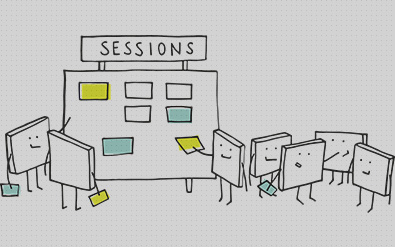By Kaitlyn Lambert, Account Executive
There are two types of people in the world, those who love brainstorm meetings and those who dread receiving that calendar invite for a brainstorm meeting.
I, myself, belong to the former category. For one, I never pass up the chance to have a captive audience to hear my ideas, and two, I think it’s one of the best ways to spark new ideas. There have been countless instances where I’ve walked into a brainstorm not sure what would come out of it, and walked out feeling like I had helped the group reach a creative solution. It feels good to get collaborative and creative.
I do realize that not everyone shares my sentiments. To some, brainstorms might not seem like a productive use of time or they may not be producing the results that were hoped for. You’re not going to strike gold every time your team gets together to throw around ideas, but there are steps you can take to set yourself up for the greatest chance of success. At the very least, implementing some sort of process will ensure that no one leaves a brainstorm meeting with negative feelings, or feeling like their ideas weren’t heard.
Make sure that everyone on your team has a chance to share their ideas
Some individuals may be in the anti-brainstorming camp because of the way brainstorming meetings are being run. These meetings are likely less structured, and more spontaneous, which doesn’t fit with the way some individuals prefer to communicate or approach a problem. Everyone has different levels of comfortability when sharing ideas, especially half-baked ideas, and some people are going to process information differently than others. While it might seem natural for some individuals to voice ideas as they come into their heads, others might need some time to digest, and think about how they want to position an idea before sharing.
One way to bridge the gap between these different types of personalities that every team likely has, is to give advance notice on the topic that you’ll be brainstorming. This gives those individuals who want to do some research or flesh out their thoughts beforehand a chance to do so, and those team members who work more creatively on the fly are still able to share their thoughts during the brainstorm session.
Another way to encourage less-vocal team members to speak up is by giving everyone time to run the discussion. Instead of having an open format to these meetings, set aside some time at the beginning so that everyone has a few minutes to share their initial thoughts and ideas on the subject. This also helps get the discussion going.
Encourage creative ideas
One of my brainstorm pet-peeves is when ideas get shot down as they’re presented. While some ideas might be outside of the real-world restrictions that exist (I’m looking at you, budget), a brainstorm session is meant to be a time to throw out any ideas, as out-of-the-box as they may be. Saying “we can’t do that” to one idea is going to make the group less creative as they all start thinking of the feasibility of their ideas before sharing them. In my experience, it’s those offbeat, “not-doable” ideas, that often spark the most creative discussion, and can result in the team finding a solution that can be executed.
It can be difficult to resist the urge to point-out flaws in someone’s idea, but remember that it’s just a brainstorming session, and there’s no need to get into the details of execution. Rather than putting an end to a train of thought by saying “we wouldn’t be able to pull that off” or “we don’t have the budget for something like that”, try encouraging the idea along by asking questions like “what would we need to pull that off?”. Now, instead of ending the discussion, the group is thinking of more creative solutions.
Don’t dismiss your own ideas before you present them
Something I’ve been guilty of in the past is presenting an idea by starting with “this might not be a good idea but…” or “we probably couldn’t do something like this but…”. Dismissing our own ideas before presenting them is something we do perhaps because we don’t want to be told that our ideas aren’t good, but it doesn’t help encourage positive discussion around these ideas. We have to fight the urge to be self-deprecating and just say “here’s my idea”, or “what if we tried this?”. There’s no need for a negative introduction of your own ideas because it’s a brainstorm and there are no bad ideas!
Brainstorming can be a great way to come up with ideas for everything from executing a marketing campaign, to finding unique angles for pitches. It’s also a great way for your team to get together and have some fun getting creative. Working to ensure that everyone on the team has a chance to share and feels encouraged to do so will help ensure that great ideas are coming out of these meetings.
Happy Brainstorming!



